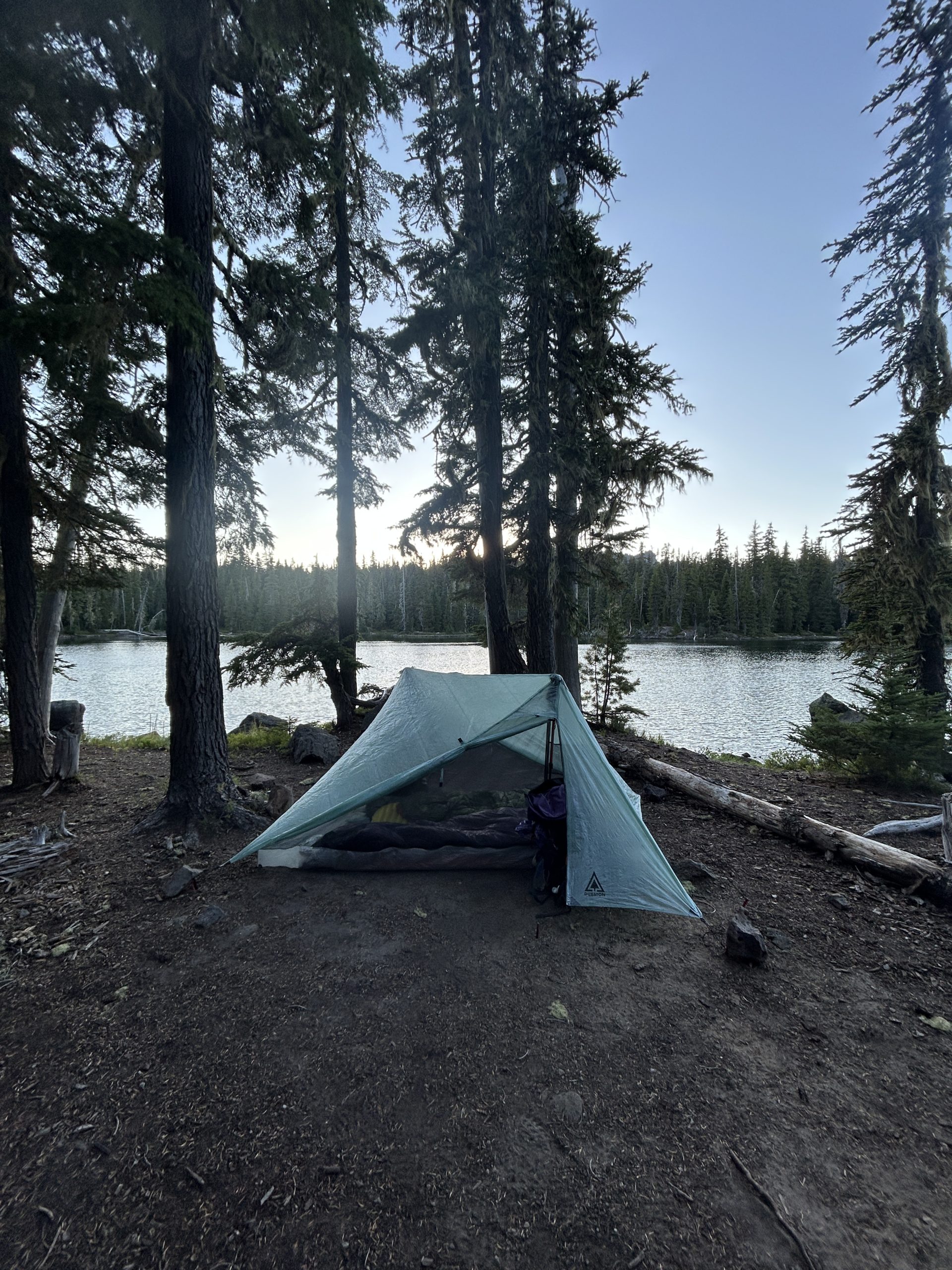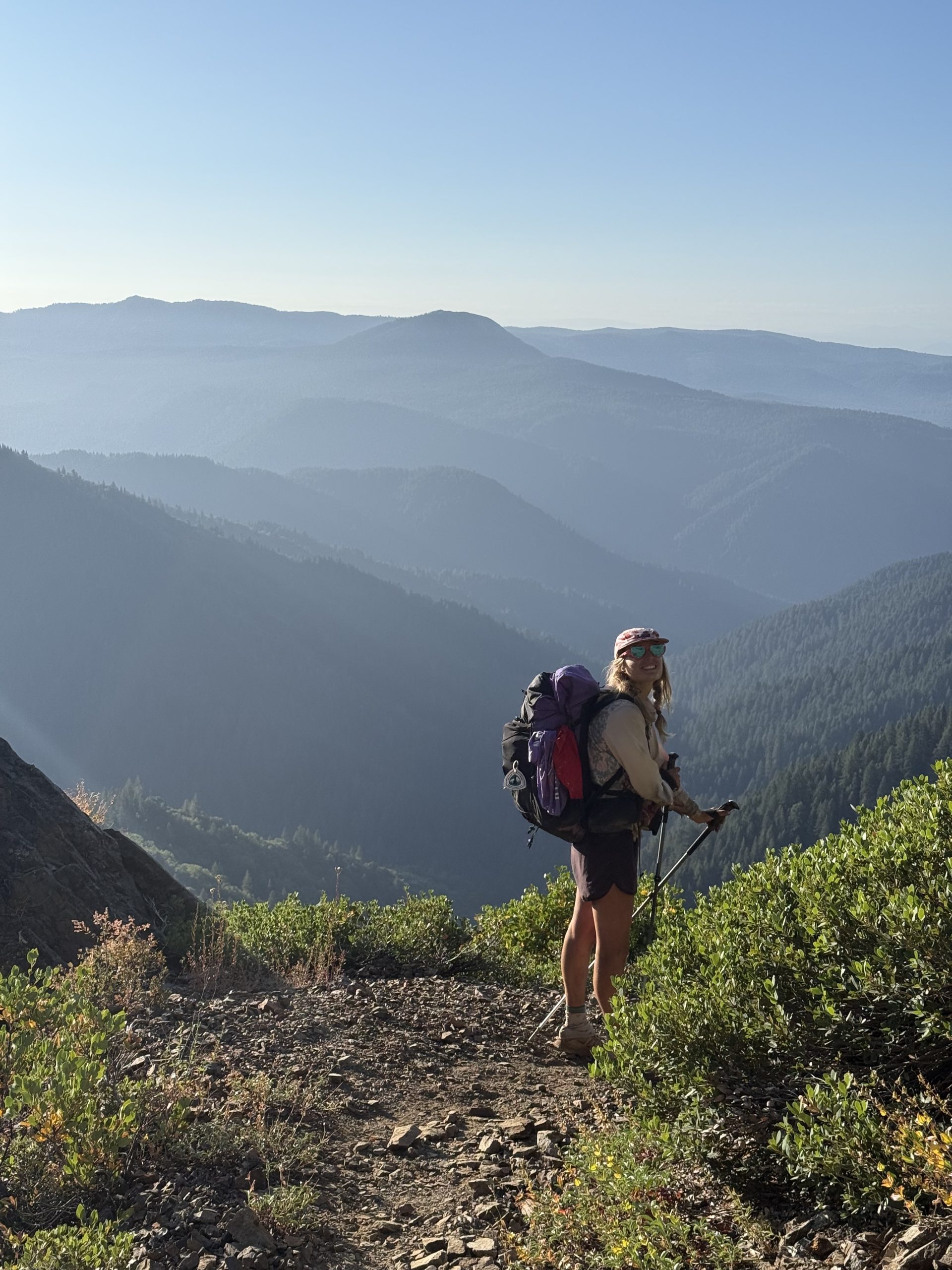About a year ago, I put together my PCT Gear List and starting gear blog for The Trek. I definitely chuckled when I re-read it two months after the tour. I didn’t know how much it would test my equipment. Five months of relying on what you can carry on your back gives you perspective on how little you really need to survive and how important it is that that gear withstands heat, sand, rain, snow and wind. So how long did it last? What went wrong? And what did I replace along the way? Keep reading to find out.
Shelter

Our Lakeside Campground in Oregon
Chowder and I wore Durston X-Mid Pro 2 (Dyneema) the entire course, as did half of our PCT class group. In the Sierra the closures of our lobbies failed. We tried zipper lube, visited the «Zipper Whisperer» in Mammoth Lakes, and tried every trick we knew, but nothing fixed the problem. Not being able to close the lobby becomes a safety issue in bad weather.
Luckily, Durston sent us a refurbished tent to Sierra City and we returned the original one. Their customer service was excellent.
While we loved the weight and many features of the X-Mid Pro 2, I didn’t love how much space the size of the tent required. It was especially difficult to find suitable campsites in Washington.
sleep system

Cowboy camping in the desert! I’m glad I had my sleeping mat and duvet to keep me warm.
My Enlightened Equipment Enigma 10° Quilt kept me warm throughout the ride. Sometimes it’s too hot!
I used the Big Agnes Rapide SL sleeping pad until White Pass, WA when it started to deflate and I couldn’t locate the leak. Luckily, we had a spare Therm-a-Rest NeoAir at my mother-in-law’s house, so I switched to it for the rest of the ride. The Rapide SL felt luxurious with its height and width, and its R-value of 4.8 kept me warm. It was a little heavier than other UL pads, but a good night’s sleep is worth it.
My NEMO Fillo Elite pillow also survived the entire journey with no issues.
Pack
 I loved my ULA Circuit package. I had already covered several hundred miles before the PCT and lasted the entire way. One buckle broke on the Sierra, but I easily replaced it on the Mammoth. The last 500 miles were less comfortable, but that’s probably due to the weight loss. My hip belt began to dig into my hip bones. Despite that, I would recommend the Circuit to anyone curious about a UL backpack for a long haul.
I loved my ULA Circuit package. I had already covered several hundred miles before the PCT and lasted the entire way. One buckle broke on the Sierra, but I easily replaced it on the Mammoth. The last 500 miles were less comfortable, but that’s probably due to the weight loss. My hip belt began to dig into my hip bones. Despite that, I would recommend the Circuit to anyone curious about a UL backpack for a long haul.
At Kennedy Meadows South, I added the LiteAF Feather Weight Waist Pack to my setup. I loved having a fanny pack/fanny pack the rest of my hike. In fact, I still carry the same fanny pack around town.
Clothes

My four run-or-die items were the JollyGear Sun Hoodie, Vuori Running Shorts, Skida Beanie, and Pit Viper Sunglasses. I used them throughout the entire tour.
Beyond that, I went through:
- Five pairs of Altra Lone Peaks (three 7s, two 9s).
- Several pairs of Darn Tough socks.
- A Squak Mountain Co. Classic Grid fleece as a mid layer.

Like other gear, every hiker has their own shoe preference!
For outer layers, I used the Mountain Hardwear Ghost Whisperer 2. In California and Oregon, I paired it with a Frogg Toggs waterproof jacket. Light and cheap, yes, but it lacked durability and was not waterproof. In Washington, I swapped it for an REI rain jacket. Not ultralight, but much more reliable. If I were to do the tour again, I would invest in a better, lighter case.
I sent my nightshirt home early on and slept in my Grid Fleece. I kept my synthetic base layer pants for sleeping and they lasted the entire trail.
Kitchen
My BRS stove lasted until Bend, OR where I replaced it with the TOAKS Titanium stove which took me the rest of the way. My TOAKS titanium pot and Sea to Summit spoon also survived the 2650 miles.
I carried a bag of LiteAF food up to the Sierra, where we swapped to carry cans. In Northern California, we switched to Adotec Bear Safe bags for the rest of the hike.
Filtration Settings
My Sawyer Squeeze made it all the way to Mount Whitney, where I accidentally froze it while taking it to the top. Freezing compromises the filter, so at Bishop I bought a new one that lasted the rest of the way.
My first Cnoc Vecto bag suffered a catastrophic cut on the fourth day. I found a “new” one in a hiker’s box at Kennedy Meadows South and used it to the end. Cnoc later gave me two Thru Bottles, which I used for most of Washington instead of the Smartwater bottles.

Testing Cnoc Thru bottles in Washington
Survival and first aid

Our Garmin inReach made it to the end. I adjusted my first aid kit as needed, but I’m so glad I brought one.
In the Sierra, I used Kahtoola MICROspikes and shipped them home to Pinecrest, CA, along with my Corsa ice axe.
Electronics

My Anker power bank died when I got to Big Bear. I replaced it with a different brand’s 10,000 mAh bank for $10 that I bought at Marshall’s. Later, I ordered the popular Haribo 20,000 mAh ultralight battery bank from South Lake Tahoe.
I used the same wireless Bluetooth headphones that I bought on Amazon years ago.
Our luxury item, the Flextail Zero pump, also survived the entire PCT. It was fading fast near the northern terminus, but went to work pumping out two mats every night for more than 150 days.
Final thoughts
Overall, most of my gear survived the 2650 miles. Researching thoroughly and testing everything before starting made a big difference. And honestly, some of it is also down to luck.
I hope this breakdown helps future PCT hikers purchase their gear and find what works for their hike.

This website contains affiliate links, which means The Trek may receive a percentage of any products or services you purchase using links in articles or advertisements. The buyer pays the same price they would otherwise pay, and their purchase helps support The Trek’s ongoing goal of bringing you quality backpacking information and advice. Thank you for your support!
For more information, visit the About page of this site.




:max_bytes(150000):strip_icc():focal(718x336:720x338)/Cynthia-Erivo-Wicked-112025-tout-ae960881d0a0449da8496dfd8d276fee.jpg?w=238&resize=238,178&ssl=1)